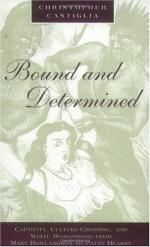|
This section contains 4,467 words (approx. 15 pages at 300 words per page) |

|
SOURCE: “Mary Rowlandson: Captive Witness,” in So Dreadfull a Judgement: Puritan Responses to King Philip's War, 1676-1677, edited by Richard Slotkin and James K. Folsom, Wesleyan University Press, 1978, pp. 301-12.
In the following essay, Slotkin and Folsom examine Rowlandson's work as both a captivity narrative and part of Puritan mythology and culture.
“On the tenth of February 1675, came the Indians with great numbers upon Lancaster: Their first coming was about sun-rising; hearing the noise of some guns, we looked out; several houses were burning and the smoke ascending to heaven.” So Mrs. Mary Rowlandson begins the first and probably the finest example of a uniquely American literary genre, the so-called captivity narrative: that is, the history of a white European—or later, an American—made captive by hostile Indians and of what transpired between his or (more generally) her capture and ultimate release.
The captivity narrative found immediate...
|
This section contains 4,467 words (approx. 15 pages at 300 words per page) |

|


